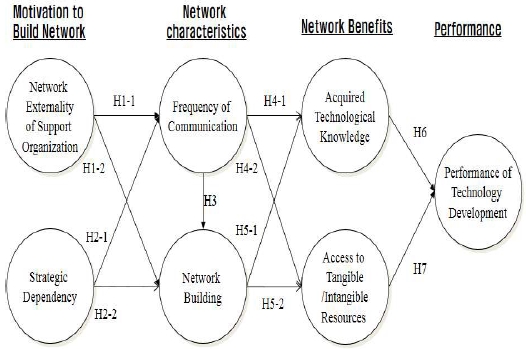
Effect of SME's Network Establishment and Activity on Knowledge Acquisition and Technology Development Performance
Copyright ⓒ 2020 The Digital Contents Society
This is an Open Access article distributed under the terms of the Creative Commons Attribution Non-CommercialLicense(http://creativecommons.org/licenses/by-nc/3.0/) which permits unrestricted non-commercial use, distribution, and reproduction in any medium, provided the original work is properly cited.

Abstract
The current study investigated the effects of network building between support organizations of small and medium enterprise (SME) and SMEs. Major findings of the study were: strategic dependency was shown to have a greater effect than support organizations' network externality on frequency of communication with support organizations and strategic dependency; though frequency of communication between support organizations and SMEs increased network building, which facilitated acquired technological knowledge and access to tangible/intangible resources, the effect of frequency of communication itself on either was not significant; and acquired technological knowledge and access to tangible/intangible resources enhanced performance of technology development, indicating a successful aspect of the government policy on supporting.
초록
본 연구는 중소기업의 지원조직과 기업간 네트워크 구축 효과를 조사하였다. 연구결과, 중소기업의 전략적 의존성은 지원 조직과의 커뮤니케이션 빈도 및 전략적 의존성에 지원 조직의 네트워크 외부성보다 더 큰 영향을 미치는 것으로 나타났다. 지원 조직과 중소기업 간의 커뮤니케이션 빈도가 네트워크 구축을 증가시켜 습득한 기술 지식과 유/무형자원에 대한 접근을 촉진했지만, 커뮤니케이션 빈도 자체가 미치는 영향은 크지 않았다. 또한 습득한 기술 지식과 유/무형자원에 대한 접근은 기술개발의 성과를 높여 지원에 대한 정부정책의 성공적인 측면을 나타냈다.
Keywords:
Small and Medium Enterprise (SME), Network Building, Frequency of Communication, Acquired Technological Knowledge, Access to Tangible/Intangible Resource, Performance of Technology Development키워드:
중소기업, 전략의존성, 커뮤니케이션 빈도, 네트워크 구축 및 활동, 지식습득, 기술개발 성과Ⅰ. Introduction
Nowadays, SMEs are faced with new competitive environment, such as globalization, increased and diversified consumer demand, reduced market reaction time, and deregulation. These changes in the environment that heighten competitiveness require companies to take interaction efforts with other economic entities for their survival and success[1]. Relationships with other companies have become one of the most important issues in Korea, which has experienced restructuring and has seen large companies, the foundation and past model of industry development, being divided into individual small and medium-sized companies due to the financial crisis in 1997. While SMEs have advantages in their flexibility and agility, they also have disadvantages in that they cannot meet the new competitive demand by themselves because of its relatively small scales and lack of accumulated resources[2]. Under the circumstances, the significance of network is growing as a model for seeking efficiency as group companies and creativity as an individual company and at the same time for being equipped with competitive scales and competencies and for promptly coping with environmental changes. Moreover, a growing recognition is that SMEs can successfully respond to market changes through stronger mutual relationships. Though the importance of network between companies has been posited, little research has been carried out to examine the benefit from network between companies and organizations. The current study was conducted to investigate the effect of network building between companies and their support organizations on performance of technology development.
Ⅱ. Theoretical Background
2-1 Network and the resource dependence theory from the resource-based view
Resource-based view emphasizes the importance of internal resources a company owns[3]. Companies heavily invest in generating irreplaceable resources to deal with rapid market changes and to prevent other companies from emulating them. Nevertheless, SME in a poor environment is limited in generating inimitable/irreplaceable resources and developing them as their core competency. Therefore, Powell, Koput et al., (1996) suggest that collaboration and alliance with external entity can play an important role in building core competency of a company[4]. According to the resource dependence theory from the resource-based view, the goal of alliance between companies is to make up for their lacking competencies and to effectively develop them. From this notion the term strategic dependency was made, which means the goal cannot be achieved without the other’s assistance. After all, the resource dependence theory from the resource-based view also acknowledges the significance of collaborative relationships with external entity for effective absorption of internal resources and core competency development. The current study was conducted to look into the relationship between companies and their support organizations, which has been little studied in previous research, on the basis of the network theory and to explore the process toward network benefits.
2-2 Motivations and characteristics of SME network, benefits of network and performance of technology development
Network externality of an organization can be explained with the product innovation theory. According to the product innovation theory, network effect is explained as product value or utility is increased along with the increase in consumers of the product or the company[5]. In this sense, network externality of an (government-related support) organization means that companies feel utility value in building network with government-related support organizations since the organizations build relationships with many groups such as companies, consultative bodies, organizations, etc. In other words, in strategic dependency mutual collaboration is utmost important for each other. Unofficial network with people in charge, defined as not-work related unofficial relationship, is based on mutual trust. That is, time and efforts are put into unofficially built relationships outside work because of their impact on successful management of the company[6].
When a company understands and utilizes interdisciplinary knowledge, it can enhance its capabilities to grasp the market trend and consumer need and to cope with rapidly changing environment[7]. In the meantime, it can acquire and optimize target technology in a relatively short period of time with its improved accessibility to resources, such as diverse market information and facilities, which can help industry commercialization. As to the factors affecting company innovation, Freel (2005) stated that company innovation begins with knowledge acquisition based on education and training of professional human resources, marketing technology, and collaborative technology development[8]. Therefore, in order to minimize economic losses through strategic agreement and to maximize economic utility value through external network, companies are supposed to build network with support organizations in the region that have outstanding competencies of supporting companies and establishing network[9]. Related hypotheses are established as follows :
- H1-1 : The network externality of SEM's support organization is likely to affect the frequency of communication.
- H1-2 : The network externality of SEM's support organization is likely to affect its network building.
- H2-1 : The SEM's strategic dependency is likely to affect the frequency of communication.
- H2-2 : The SEM's strategic dependency is likely to affect its network building.
- H3 : The frequency of communication with SEM's local partners is likely to affect its network building.
- H4-1 : The frequency of communication with SEM's local partners is likely to affect its acquisition of technological knowledge.
- H4-2 : The frequency of communication with SEM's local partners affect its access to tangible and intangible resources.
- H5-1 : The SEM's network building with local partners is likely to affect its acquisition of technological knowledge.
- H5-2 : The SEM's network building is likely to affect its access to tangible and intangible resources.
- H6 : The SEM's acquisition of technological knowledge is likely to affect its performance of technological development.
- H7 : The SEM's access to tangible and intangible resources is likely to affect its performance of technological development.
Ⅲ. Research Methodology
3-1 Research Model
Figure 1 shows the research model to test the hypotheses. In this study we attempted to examine the effects of SME’s motivation to build its networks on frequency of communication and actual network building and further on the network benefits and performance of technology development.
3-2 Sample of the Study and Data Collection
The data of the study was collected with SMEs that were supported by government-related institutes such as domestic Technoparks, KOTRA, and Small and Medium Business Administration. The scope of respondents was limited to those who have the best knowledge about the company, namely, CEOs, directors, and managers in technology, in order to measure the viewpoint of the companies. In addition, the survey was limited to one person per company in order to secure representativeness. A total of 220 questionnaires were distributed and 174 were returned. 168 questionnaires were used in the final analysis excluding incomplete 6 questionnaires.
3-3 Sample Characteristics
Respondents consisted of 156 males (92.9%) and 12 females (7.1%). Fifty-five respondents (32.7%) were in their 30’s, 76 (45.2%) in their 40’s, and 37 (22.1%) in their 50’s. Fifty-three respondents (31.5%) were CEO’s and directors, 61 (36.3%) were in management positions (head of a research institute or a department), and 54 (32.2%) were section chiefs or team captains. Seventy-seven respondents (45.8%) had worked for 4-5 years, 34 (20.2%) for 6-10 years, 26 (15.5%) for 11-15 years, 19 (11.3%) for 16-20 years, and 12 (7.2%) for 21 years or longer.
3-4 Measurement of Variables
In order to investigate the effects of building network with support organizations on performance of technology development, the current study employed the measurement whose validity and reliability are verified in previous studies on network externality of organizations, strategic dependency, frequency of communication, network building with regional partners, acquired technological knowledge, access to tangible/intangible resources, and performance of technology development. Items in those studies were revised and adapted appropriately for the present study. 5-point Likert scale was used for most items, 1 being “strongly disagree” and 5 being “strongly agree.”
Ⅳ. Data Analysis
4-1 Validity and Reliability Test
Confirmatory factory analysis was conducted to guarantee the validity and reliability of variable. Testing reliability with Cronbach’s coefficients, all the coefficients were within the range of .770~.903. Showing the reliability of the construct variables. Analytical results appear that the measurement model for this research has a strong convergent validity, showing every parameter estimated values over (see Table 2)[10]. In addition, representativeness of the constructs was verified from the composite reliabilities ranging .774~.906 which were higher than the commonly accepted level of . 7[11].
4-2 Results of Discriminant Validity Analysis
Model testing for discriminant validity used the method proposed by Bagozzi et al.(1981b)[12]. That is χ2 value difference tests were employed, comparing scores between constrained and unconstrained models. The difference tests among 7 constructs of this research model were performed with 42 t-test analyses, dividing constrained and unconstrained models. The results confirmed significantly the discriminant validity.
4-3 Results of Hypotheses Testing
The analysis of the goodness of fit indexes of the research model showed χ2=441.09, df=158(p=.000), GFI=.91, AGFI=.88, NFI=92, CFI=.95 RMR=.049 suggesting the superiority of the research model. The results of the analysis of causal relationships among the variables are shown in <Table 5>.
Ⅴ. CONCLUSION AND IMPLICATIONS
5-1 Summary of Findings and Implications
The summary of findings in this study and their implications are as follows:
First, strategic dependency was shown to have a greater effect than support organizations' network externality on frequency of communication with support organizations and strategic dependency. The finding shows that the competencies of support organizations can enhance communication with SME in diverse aspects, which can make up for SME’s limitation in resources, implying the urgency of securing the competencies of support organizations whereas it is also important to set up policies for support programs.
Second, though frequency of communication between support organizations and SMEs increased network building, which facilitated acquired technological knowledge and access to tangible/intangible resources, the effect of frequency of communication itself on either acquired technological knowledge or access to tangible/intangible resources was not significant, which indicates the possibility of obtaining management resources that contribute to the firm’s competencies is enhanced when relational characteristics of network are built. Therefore, while it is important to form structural network that provides more communication opportunities with support organizations, in order to facilitate more effective utilization and access to resources it is recommended to find ways to establish trust among network members, to seek mutual benefits, and to value the goal of all network members. Technology, human resources, capital, systems, and manufacturing facilities are the factors that directly affect management activities. However, some kind of community awareness should be formed for these factors to be shared. The role of support organizations as an intermediary is to continuously provide foundation for activating networking among related organizations, such as holding seminars on new technology trend, hosting official and unofficial meetings with regional leaders, and distributing network information. They also need to be able to coordinate and connect organizations with similar functions by internally reinforcing their capability of managing outstanding human resources and organizations.
Lastly, acquired technological knowledge and access to tangible/intangible resources enhanced performance of technology development, indicating a successful aspect of the government policy on supporting SMEs. The results of the study showed positive short-term performance. More importantly, the effect of relations is shown in various aspects, implying the need to promptly build an integrated platform of technology and management support for SME support programs on an integrated and continuous basis.
5-2 Limitation and implications for future studies
The current study investigated the effects of network in an attempt to explore a relational aspect between SMEs and their support organizations, centering on intensity and establishment of network. To understand performance of technology development through SME network, hierarchy and centrality of network also need to be studied in future studies regarding the structural aspect of network.
The current study focused on the process of network between SMEs and their support organizations that affect performance of technology development. Further research needs to be conducted encompassing more various factors that can affect performance of technology development, such as technology commercialization capacities.
Acknowledgments
“This study was supported by research fund from Chosun University, 2020”
References
- The Economist, “Internet Pioneers: We Have Lift-off,” 358(8207), pp.69-71, 2001.
- Y. S. Kim, K. S. Han, "A study on factors Affecting Performance Assessment of Small and Medium Business R&D Project," Journal of Digital Contents Society, vol.19, No.3, pp.595-603, 2018.
- W. W. Powell, Neither Market Norhierarchy : Network Forms of Organization ,in Staw, B. and Cummings, L.(eds.), Research in Organizational Behavior, 12, Green witch, CH:JAI Press, pp.295-336, 1990.
-
W. W. Powell, Koput, K. W., and Smith-Doerr, L., "Interorganizational Collaboration and the Locus of Innovation: Networks of Learning in Biotechnology," Administrative Science Quarterly, 41, pp.166-145, 1996.
[https://doi.org/10.2307/2393988]

- M. Katz and C. Shapiro, "Network Externalities, Competition and Compatibility," American Economic Review, 75(3), pp.424-440, 1985.
-
M. W. Peng, and Y. Luo, "Managerial Ties and Firm Performance in a Transition Economy: The Nature of a Micro-Macro Link," Academy of Management Journal, 43(3), pp.486-501, 2000.
[https://doi.org/10.5465/1556406]

-
M. R. Darby, L. G. Zucker, "Growing by leaps and inches: creative destruction and the Crusonia plant," Econ.Inq. 40 inpress, 2002.
[https://doi.org/10.3386/w8947]

-
M. S. Freel, "External Linkages and Product Innovation in Small Manufacturing Firms," Enterpreneurship and Development, 12, pp.245-266, 2005.
[https://doi.org/10.1080/089856200413482]

-
Y. S. Kim, "The Effects of IT System Utilization of SME on the Environment Management Performance," Journal of Digital Contents Society, vol.20, No.1, pp.529-537, 2020.
[https://doi.org/10.9728/dcs.2020.21.3.529]

- M. Browen, W. and R. Cudeck, “Alternative Ways of Assessing Model Fit,” in A. Bollen and J. S. Long(Eds.), Testing Structural Equation Models, Newbury, CA. Sage, pp.136-162, 1993.
-
C. Fornell and D. F. Lacker, "Evaluating Structural Equation Models with Unobservable Variables and Measurement Error," Journal of Marketing Research, vol.18, No.1, February, pp.39-50, 1981.
[https://doi.org/10.1177/002224378101800104]

-
R. P. Bagozzi, “"An Examination of the Validity of Two Models of Attitude,”" Multivariate Behavioral Research, 16, July, pp.323-359, 1981b.
[https://doi.org/10.1207/s15327906mbr1603_4]


1999 : Chosun University, Master
2007 : Chosun University, Ph.D
2009~2014: Chosun University BK21 ‘Industrial Marketing Team’ Research Professor
2015~2017: Chosun University SSK Research Professor
Now: Chosun University Assistant Professor
※Research Area: Consumer Behavior, Management of Technology, Industrial Policy

1977 : Korea University, BA
1984 : Ohio University, MBA
1991 : University of Arizona, Ph.D
2006~2013: Chosun University BK21 ‘Industrial Marketing Team’ Senior Professor
2007~2008: President of the Korean Marketing Management Association
2013~2014: President of the Korean Marketing Association,
Now: Chosun University Emeritus Professor
※Research Area:Consumer Behavior, Management of Technology, Industrial Policy

